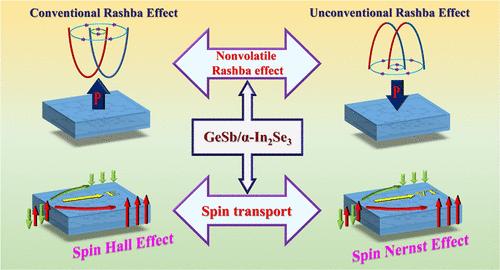Nonvolatile Rashba Effect via Ferroelectric Switching in the GeSb/α-In2Se3 Heterostructure: Implications for Spintronics and Spin-Caloritronics
IF 3.2
3区 化学
Q2 CHEMISTRY, PHYSICAL
引用次数: 0
Abstract
Ferroelectric (FE) Rashba semiconductors represent a burgeoning class of multifunctional materials with immense potential for next-generation spintronic and spin-caloritronic applications. In this work, we present a comprehensive first-principles investigation of the GeSb/α-In2Se3 van der Waals (vdW) heterostructure, focusing on the interplay among FE polarization, interfacial charge transfer, and spin-dependent electronic properties. The intrinsic FE polarization of α-In2Se3 in the heterostructure enables reversible modulation of Rashba spin splitting (RSS) and spin transport behavior. Under upward polarization (P↑), RSS emerges at the Γ point of the conduction band with a large Rashba coefficient of 1.32 eV Å, displaying a conventional spin texture. Conversely, downward polarization (P↓) shifts the RSS to the valence band, yielding a Rashba coefficient of 0.93 eV Å with an unconventional spin texture. This polarization-dependent reconfiguration of the band structure is driven by interfacial charge redistribution, which amplifies the internal electric field and spin–orbit coupling effects. Moreover, both spin Hall conductivity and spin Nernst conductivity exhibit strong tunability with FE switching and Fermi level adjustment, enabling efficient control over spin transport phenomena. Our results reveal the GeSb/α-In2Se3 heterostructure as a promising candidate for multifunctional device applications, including nonvolatile memory, advanced logic circuits, spintronics, and spin-caloritronics.

GeSb/α-In2Se3异质结构中铁电开关的非易失性Rashba效应:自旋电子学和自旋热电子学的意义
铁电(FE) Rashba半导体是一种新兴的多功能材料,具有下一代自旋电子和自旋热电子应用的巨大潜力。在这项工作中,我们对GeSb/α-In2Se3 van der Waals (vdW)异质结构进行了全面的第一性原理研究,重点研究了FE极化、界面电荷转移和自旋相关电子性质之间的相互作用。α-In2Se3在异质结构中的本征FE极化能够可逆地调制Rashba自旋分裂(RSS)和自旋输运行为。在向上极化(P↑)下,导带Γ点出现RSS, Rashba系数较大,为1.32 eV Å,呈现常规自旋织体。相反,向下极化(P↓)将RSS转移到价带,产生Rashba系数0.93 eV Å,具有非常规的自旋结构。这种极化相关的能带结构重构是由界面电荷重分配驱动的,界面电荷重分配放大了内部电场和自旋轨道耦合效应。此外,自旋霍尔电导率和自旋能态电导率在FE开关和费米能级调节下都表现出很强的可调性,从而能够有效地控制自旋输运现象。我们的研究结果表明GeSb/α-In2Se3异质结构是多功能器件应用的有希望的候选材料,包括非易失性存储器,高级逻辑电路,自旋电子学和自旋热电子学。
本文章由计算机程序翻译,如有差异,请以英文原文为准。
求助全文
约1分钟内获得全文
求助全文
来源期刊

The Journal of Physical Chemistry C
化学-材料科学:综合
CiteScore
6.50
自引率
8.10%
发文量
2047
审稿时长
1.8 months
期刊介绍:
The Journal of Physical Chemistry A/B/C is devoted to reporting new and original experimental and theoretical basic research of interest to physical chemists, biophysical chemists, and chemical physicists.
 求助内容:
求助内容: 应助结果提醒方式:
应助结果提醒方式:


